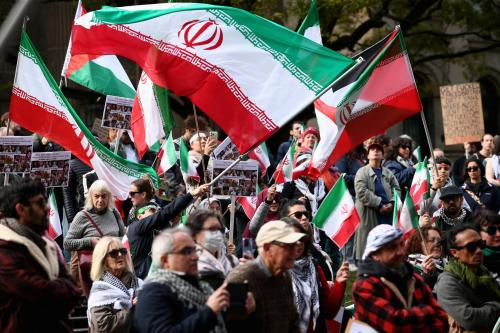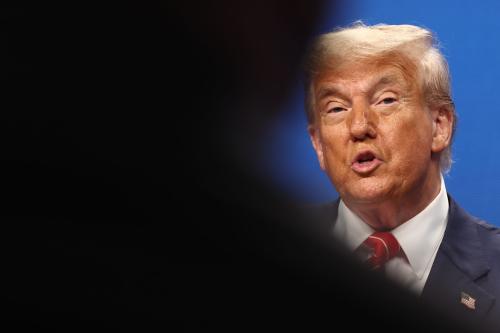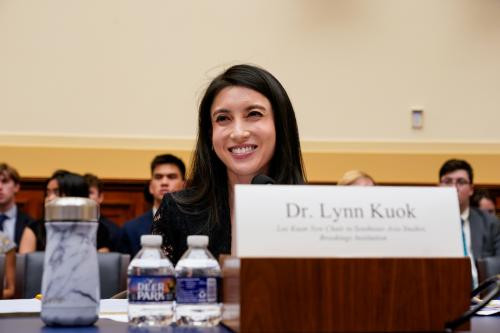The past two months have witnessed a number of dramatic shifts in the U.S.-North Korean nuclear dynamic. And at the moment, these events are shaping up in a way that suggests a new nuclear crisis on the not-too-distant horizon for the Peninsula. But this time around—as opposed to the nuclear standoff in 1993-94—the tensions are likely to be far higher.
Part of the new nuclear dynamic between Washington and Pyongyang was signaled during President Bush?s State of the Union address, in which he included North Korea in the ?axis of evil.? Beyond the rhetoric, this statement highlights the seriousness the Administration places on the possibility that states which sponsor terror and pursue weapons of mass destruction (WMD) might purposely or inadvertently provide terrorist organizations with the means to develop such weapons, and use them against the United States. Given the gravity of this threat, President Bush was putting North Korea (and others) on notice that they would be held accountable by the United States were such developments to unfold.
The ?axis of evil? statement also brought renewed focus to an old problem: the proliferation of WMD, including the pursuit of nuclear weapons, among a number of states across the globe in the 1990s. This concern led to some of the more pointed language in the recently-leaked U.S. Nuclear Posture Review (NPR). Media accounts of this document reveal a more clearly defined set of considerations for the use of nuclear weapons against states which are believed to have WMD, such as North Korea.
This more clearly worded contingency planning on the part of the Defense Department is the culmination of long debate in the United States about how to deter, and, if need be, respond to WMD use by potential American adversaries such as North Korea. While this particular language in the NPR appears to be aimed at deterrence—and it is difficult to contemplate a scenario under which Washington would authorize the unprovoked, first-use of nuclear weapons—it nevertheless ratchets up the stakes in the U.S.-North Korea nuclear face-off. Moreover, the fact that the latest U.S. National Intelligence Estimate assesses that Pyongyang possesses one or two nuclear weapons suggests Washington views North Korea as a de facto nuclear weapons state, and hence is not necessarily constrained in this instance by so-called ?negative security assurances? not to use nuclear weapons against non-nuclear weapons states.
As these events have unfolded over the past two months, a third issue arose last week: the Bush Administration announced that it would not certify North Korea?s compliance with the 1994 U.S.-North Korea Agreed Framework. The move was made owing to concerns that North Korea may have hid some nuclear materials from inspectors before the verification measures of Agreed Framework were put in place. In addition, it is argued, North Korea has continued to block the inspection by international observers of other nuclear facilities of concern.
Such concerns are suggested by the recent Congressional testimony of CIA Director George Tenet, when he said North Korea was in compliance with the Agreed Framework, but only with ?that specific agreement with regard to that specific facility? covered by the agreement, implying that troubling activities are taking place elsewhere in the North. The U.S. side could also argue that Pyongyang has not taken steps to ?consistently take steps to implement the North-South Joint Declaration on the Denuclearization of the Korean Peninsula?, which was also part of the Agreed Framework.
These could be the first steps leading to the abandonment of the Agreed Framework all together. But the Agreed Framework was already in trouble and in need of modification: the target date for completion of the light water reactors—the key turning point in the Agreed Framework—is 2003, a deadline that will be missed entirely. One way or another, a central aspect of the Agreed Framework ?deal? is not going to fall into place as planned.
For these reasons, 2002-03 may mark a second nuclear crisis for U.S.-North Korean relations. But the situation is quite different from the 1993-94 crisis, and could be far more tense and difficult. To begin with, North Korea may believe itself to be in a more resilient position by dint of its improved economy, stabilized political leadership situation, and greater international recognition and legitimacy (including improved North-South relations in the context of Kim Daejung?s ?sunshine policy?). North Korea is also holding its missile test moratorium—due to expire in 2003—in its back pocket as additional leverage. As always, Pyongyang maintains—and some say it has strengthened—its conventional artillery threat poised mere kilometers north of Seoul.
On the other hand, the Bush Administration will be far less inclined to ?cut a deal? with Pyongyang and will resist steps which suggest accommodation. That stance is now backed up by the ?axis of evil? statement and the more specific inclusion of North Korea in U.S. nuclear force planning. Japan too is far more likely to support a tougher position toward Pyongyang than in the mid-1990s. And in South Korea—whatever the outcome of December 2002 presidential elections—the new political leadership is unlikely to be as favorably inclined toward Pyongyang.
Solidarity amongst Washington, Tokyo and Seoul proved a powerful incentive in gaining a more cooperative response from North Korea in the past, and will certainly be needed in the coming year. But at the end of the day, to avoid an even more tense and dangerous confrontation, it will be up to Pyongyang to move down the path of reconciliation so clearly presented before it. Unfortunately, past experience tells us the leadership in North Korea prefers the rockier road.
The Brookings Institution is committed to quality, independence, and impact.
We are supported by a diverse array of funders. In line with our values and policies, each Brookings publication represents the sole views of its author(s).



Commentary
Op-edA New Korean Nuclear Crisis?
April 3, 2002